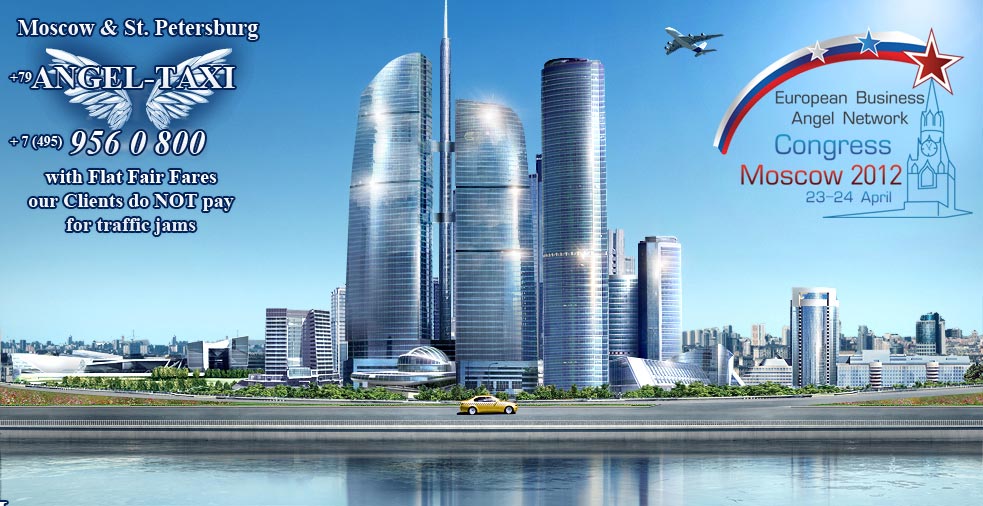Kremlin Tour+Armory Tour+Diamond Fund 2023.
Hot news! - Since Oct. 2021 it is allowed to take photos, selfies in the Armory!
Moscow Kremlin Tour is a must-see for anyone who visits Moscow for the 1st time. Kremlin is an ancient castle of the 15th c., once the residence of Russian tsars. After 1917 the Kremlin housed the Soviet government. Now the Kremlin is the residence of President of Russia.
If you want to ask re Kremlin Tour or Armory Tour pls. phone. viber. WA. TG. via +79.26435.8687 / +79.ANGEL.TOUR or hit the button 'Ask re Kremlin Tour' below.
After Peter I shifted the capital to St. Petersburg, the Kremlin lost its stately status. On the Kremlin Tour you'll see the Kremlin grounds, coronation place of Russian tsars who came to Kremlin for coronation even when Moscow wasn't Russia's capital. In 1918 the Bolshevik government moved from then Petrograd to Moscow and landed in the Kremlin's Senate building. As the Kremlin regained its status, early leaders of the USSR lived and worked in the Kremlin's old buildings. In the last decades of the Soviet regime most important state events were held in the Kremlin, where in the early 1960s Kremlin's Palace of Congresses (now, the Kremlin's State Palace, which you'll see during the Kremlin tour) was built.
The Kremlin Tour will include Kremlin Tour per se, Armory Tour and Diamond Fund. The vast majority of the articles you'll see during the Armory Tour were produced in the Kremlin workshops. Ambassadorial gifts are an essential part of the Armory Tour.
During the Kremlin Tour we'll bring you to the Russian Diamond Fund.
On the Kremlin Tour you'll see:
- Heart of the Kremlin (Kremlin Tour)
- Tsar-Bell, the biggest bell in the world (Kremlin Tour)
- Tsar-Cannon, the largest gun in the world (Kremlin Tour)
- Coronation place of Russian tsars in the Kremlin (Kremlin Tour)
- Sentries from the Kremlin regiment (at the beginning or end of the tour)
We offer tours in Moscow not only in English! Pls mention if you want to book tours in Moscow (incl. Kremlin Tour) with guides speaking Spanish, French, German, Chinese, Portuguese, Japanese etc.
DOs and DON’Ts for the Kremlin Tour:
- DO ask questions. We, Kremlin Tour guides, enjoy when visitors ask questions.
- DO take pictures while outdoors on the Kremlin territory during the Kremlin Tour.
- DON’T bring anything looking as weapons to the Kremlin Tour.
- You will take the Kremlin Tour to know about its past. The Kremlin Tour guides’ job is tough. Pls, DON’T ask Kremlin Tour guides any questions irrelevant to Kremlin Tour (e.g. Kremlin’s current home/foreign policy).
- DON'T be late for the Kremlin Tour.
Kremlin Tour is offered any day except Thur.
Take the tour to the Kremlin, Moscow’s cradle, the ancient city that united disparate principalities to become the capital of the centralized Russia.
The history of the Moscow Kremlin, its monumental walls and towers, golden-domed cathedrals and churches, magnificent palaces will be covered during the Kremlin Tour.
Especially majestic is the view on the Kremlin from the Stone Bridge, the vista well known around the world and which you can see during the Moscow City Car Tour. Eight centuries ago, though, both the walls, towers and buildings of the Kremlin looked differently. Take this watercolor tour of the Kremlin in the past.
Daniil was Moscow's first Prince who, while adorning the Kremlin, built a number of white-stone cathedrals instead of earlier wooden ones.
In 1339-40 his son Ivan Kalita constructed an impressive oak citadel on the Borovitskiy Hill whose walls were 2 to 6 meters thick and no less than 7 meters high.
In 1367 the first stone was laid in the foundation of the new Kremlin walls made of white stone. We still can see part of that wall during the Moscow City Car Tour. The white-stone Kremlin was completed in just 1 year. The construction of the white-stone Kremlin was an important event in the history of the northeastern Old Russia as it marked the rise of Moscow. The newly built Kremlin fortress was tested in the war with Lithuanian prince Olgerd who besieged Moscow in 1368. The Lithuanian troops stood for 3 nights and days at Kremlin's white-stone walls which proved to be secure.
The Fun Palace (1651) is almost hidden in between the Kremlin's State Palace and the Kremlin's wall. We cannot come close to it, as it houses the Kremlin Commandant's Office, but we can see it from the corner of the Grand Kremlin Palace.
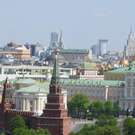

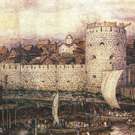
The Moscow Kremlin (or simply the Kremlin) is at the heart of Moscow. We’ll bring you to the Kremlin Tour from any spot in Moscow.
The Moscow Kremlin overlooks Red Square, thus Kremlin Tour can be taken before or after the Red Square Tour. The Kremlin is located on the Borovitsky hill whose name was derived from Borovsk, a major center of that time whose builders were engaged in 1366-1367 in the «white-stone Kremlin» construction.
We offer Kremlin Tour of The Moscow Kremlin, the best known of Kremlins.
The Moscow Kremlin includes palaces, cathedrals and the enclosing Kremlin Wall with Kremlin towers. During the Kremlin Tour you can visit Patriarch’s Palace (17th cen.), incl. Cross Chamber which displays many items made in Moscow and the Kremlin. The Kremlin's masters' style was characterized by sophisticated plainness and the elegance of the clear and austere ornamentation.
The Moscow Kremlin includes Grand Kremlin Palace, President's parade residence. Tourists visit Grand Kremlin Palace only during Grand Kremlin Palace Tour.
Cathedral Square is the heart of the Kremlin Tour.
‘The Kremlin’ is often used as a synonym to refer to Russian government, just as earlier ‘the Kremlin’ was used to refer to the government of the USSR. Thus ‘Kremlinology’ is a science not about the architectural Kremlin, but about Soviet and Russian politics. We do not deal with Kremlinology during Kremlin Tour.
Prince Ivan the Great, who assumed the title of the Ruler of All Russia, built the present-day redbrick walls and towers of the Moscow Kremlin. He invited Italian architects to rebuild the new Kremlin wall and towers, the new Kremlin palace for the prince and cathedrals of the Kremlin and you will see some of them during the Kremlin Tour, e.g. the Assumption Cathedral, which is a real tour de force.
The Tsar Cannon is another tour de force to see during the Kremlin Tour. Several Tsar Bells were cast in the Kremlin and you'll learn more thereof in the Kremlin Tour.
The Kremlin saw Moscow rising, from which czar Peter fled to 'Russian Vatican'.
The south-western part of the Kremlin holds the Armoury. The Secret Garden along the southern wall of the Kremlin can be seen (but not visited) during the Kremlin Tour.
The Kremlin was closed for Kremlin tour for foreign tourists until 1950s. Can you imagine there was not a single Kremlin Tour to book then?

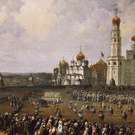
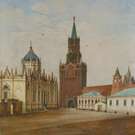


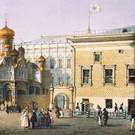

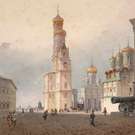
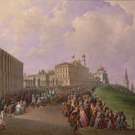
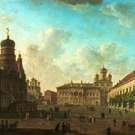
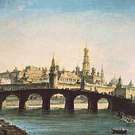

We took the Kremlin tour with a very nice and knowledgeable guide Alexander. We were able to jump the queues at both the Kremlin gate and the Armory entrance. This is also the only Kremlin tour I can find that includes a visit to the Diamond Fund, which is eye opening. Highly recommend.
Hui, Australia
We spent most of the day in the Kremlin. Of course, went into St. Basil's, and many interesting things within the Kremlin.
Angel's Tour of the Moscow Kremlin review by Edda, California, USA
My wife and I have enjoyed the Kremlin tour very much and it was tremendous. We do greatly appreciate and admire the Kremlin tour.
Angel's Tour of the Moscow Kremlin review by Ahmed, Maldives
For over 5 centuries, the Kremlin has been protected by the merloned redbrick walls and mighty towers. Some tourists dream to have a tour to the Kremlin towers. Unfortunately, such a tour in the Kremlin is not possible – none of the towers of the Kremlin is open for tours, but those interested could have a tour of the Kremlin towers of Rostov. In the modern Russian 'Kremlin towers' mean competing factions of the regime. Below is a brief history of some of the Kremlin towers.
Italian engineer Antonio Gilardi built the strong Tainitskaya Tower on the site where the Cheshkov Gate of the white-stone Kremlin earlier stood. In 1487 Italian engineer Marco Fryazin built the Beklemishchevskaya corner-tower. A year Water-Supplying corner-tower appeared on the opposite side of the wall. By the early 1490, the southern side of the Kremlin wall was completed: 4 more towers were erected and new Kremlin walls were built. In the 1490s the Kremlin project was headed by Pietro Solari. The Kremlin finally became the majestic fortress of today. The leading engineers and builders of the Kremlin were Italians. By 1495 the new walls and towers of the Kremlin were completed, but the Kremlin was to be further reinforced. In 1670-80s, all the Kremlin's towers were overbuilt with stone marquees with beautiful tiled roofs. In 1812 Napoleon ordered to blow up the Kremlin. Some towers were seriously damaged, but all the Kremlin's structures damaged by Napoleon's troops were reconstructed. The last major construction project in the Kremlin's territory in the 19th cen. was the Grand Kremlin Palace. Read more on the page of the tour to Kremlin's Grand Palace.
Nikolskaya Tower’s drawbridge at the side-strelnitsa let visitors pass over the moat on Red Square and enter the Kremlin. Spasskaya Tower, the Kremlin's most famous tower was built on the site of the ancient white-stone Kremlin's Frolovskaya strelnitsa and as it stood near the Frol and Laur Church inside the Kremlin. The tower protected the Kremlin's northeastern side. In 1658 the tower of the Kremlin's main gate was renamed Spasskaya. From then on, it was recognized as the Kremlin's main tower. Alarm Bell's Tower was given its present-day name in 1658, when the major alarm bell of the Kremlin's fire brigade was stationed inside. The Water Supplying Tower stands at the corner of the Kremlin Embankment. It protected the Neglinnaya River's mouth. Returning to the Borovitskaya Tower, we have completed the walking tour around Kremlin. And now let us go inside to admire the beauty of the Kremlin's cathedrals.
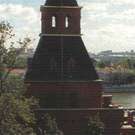

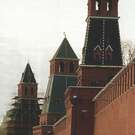

In late 15 th cen. Ivan III decided to commission well experienced foreign architects to build the Kremlin's main cathedral. In 1508 the Kremlin turned into an island and the Kremlin's territory grew to its present-day size. A new Kremlin Palace was built whose parade hall the Faceted Chamber has survived (and is part of the Grand Kremlin Palace Tour) as well as the Kremlin's main cathedrals were built which are part of the Kremlin Tour. Cathedral Square is the heart of the Kremlin Tour. From the top of the Ivan Bell Tower, one could see the vistas around the Kremlin within 30 km.
The 17 th cen. saw many construction projects in the Kremlin's territory. Instead of dilapidated wooden palaces, new stone ones were built, incl. the Terem Palace, a major masterpiece of its time, part of the Grand Kremlin Palace Tour and the Patriarch's Palace for the Russian Orthodox Church's leader (which is part of the Kremlin Tour). In the 20th cen. the old Ascension Nunnery and Chudov Monastery of the ancient Kremlin were demolished. In the early 1930s, the Kremlin's territory was closed for the general public. Only in 1955 the Kremlin again opened its gates for Kremlin tours.
The cathedrals of the Moscow Kremlin have recently resumed their important role in the life of the Russian Orthodox Church now that holiday liturgies and special church services are conducted in them and that is when they are not open for Kremlin tours. In 1990 the Moscow Kremlin was included in the UNESCO World Heritage list.
